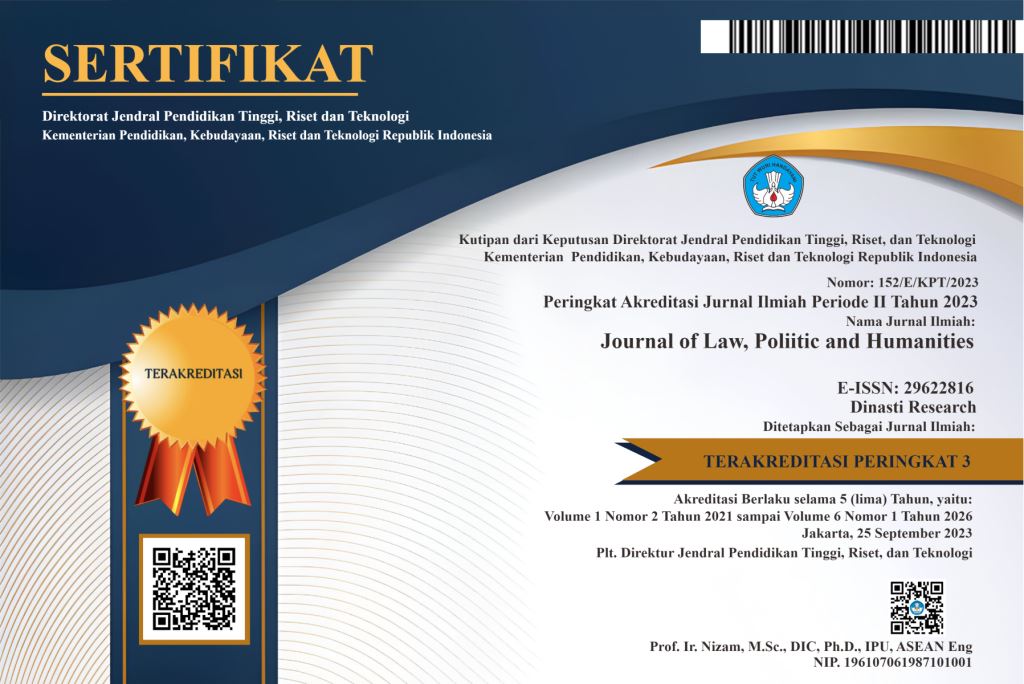The Development of General Elections and Regional Head Elections After the Reformasi Era
DOI:
https://doi.org/10.38035/jlph.v3i3.221Keywords:
Election History, Presidential Threshold, Simultaneous ElectionsAbstract
Indonesia is a constitutional state (Rechtsstaat) that upholds the values of legal norms based on laws. Indonesia has the highest legal norms, namely Pancasila and the 1945 Constitution of the Republic of Indonesia. Therefore, all forms of legislation that are made must not conflict with the 1945 Constitution of the Republic of Indonesia. in the Indonesian constitutional system experienced a very significant change. The implementation of direct and simultaneous elections in the post-reform era was held on April 17 2019, which is historical in the electoral process in Indonesia. This is an implication of the Constitutional Court Decision Number 14/PUU-XI/2013 concerning the judicial review case of the Law of the Republic of Indonesia Number 42 of 2008 concerning the General Election of President and Vice President. directly by the people. Simultaneous election implementation which will be held in 2024, this has been stipulated in the Law of the Republic of Indonesia Number 7 of 2017 concerning General Elections and the Law of the Republic of Indonesia Number 10 of 2016 concerning the Second Amendment to Law Number 1 of 2015 Concerning the Stipulation of Government Regulation in Lieu of Law Number 1 of 2014 Concerning the Election of Governors, Regents and Mayors to Become Laws. The two laws mandate that in 2024 elections will be held simultaneously in 1 (one) year, namely presidential and vice-presidential elections, legislative elections and regional head elections. In addition, there is a provision regarding the presidential threshold that has existed since the 2004 election.
References
Ex book:
Undang-Undang Dasar Negara Republik Indonesia 1945
Undang-Undang Republik Indonesia Nomor 7 Tahun 2017 Tentang Pemilihan Umum, Lembaran Negara Republik Indonesia No.182,2017. Tambahan Lembaran Negara Republik Indonesia Nomor 6109
Undang-Undang Republik Indonesia Nomor 10 Tahun 2016 Tentang Perubahan Kedua Atas Undang-Undang Republik Indonesia Nomor 1 Tahun 2015 Tentang Penetapan Peraturan Pemerintah Pengganti Undang-Undang Nomor 1 Tahun 2014 Tentang Pemilihan Gubernur, Bupati dan Walikota menjadi Undang-Undang.Lembaran Negara Republik Indonesia Tahun 2016 Nomor 130, Tambahan Lembaran Negara Republik Indonesia Nomor 5898
Ex journal:
Syahuri, Taufiqurrohman, Muhammad Helmi Fahrozi, 2020, ”Konstitusionalitas Pasal 222 Undang-Undang Republik Indonesia Nomor 7 Tahun 2017 TentangPemilihan Umum (“Presidential Threshold), Al Wasath, Vol.1,No.1: 25-34
Dedi, Agus, 2019, “Analisis Sistem Pemilihan Umum Serentak, Jurnal Moderat, Vol.5, No.3:213-216
Ghoffar, Abdul, 2018, “Probematika Presidential Threshold Putusan Mahkamah Konstitusi dan Pengalaman di Negara Lain”, Jurnal Konstitusi, Vol.15, No.3:480-501
Hidayatullah, Faisal, Hananto W, Herzon Sabar Rotua, Tinambunan, 2019, “Analisis Juridis Putusan Mahkaman Konstitusi Nomor 53/PUU-XV/2017 Berkaitan Dengan Penolakan Uji Materi Presidential Threshold Dalam Pengusulan Calon Presiden dan Wakil Presiden Pemilihan Umum Serentak 2019”, Jurnal Novum, Vol.5, No.2: 104-116
Sholihah, Ratna, 2018, “Peluang dan Tantangan Pemilu Serentak 2019 Dalam Perspektif Politik, Jurnal Ilmiah Pemerintahan, Vol. 3, No. 1: 73-88
Ex Internet:
Tribunnewes.com. “Kisah Pilu TKW Indonesia, 1,5 Tahun Disiksa Majikan hingga Gaji Sebesar 567 Juta Tak Dibayarkan”, Available online https://www.tribunnews.com/nasional/2019/07/30/kisah-pilu-tkw-indonesia-15-tahun-disiksa-majikan-hingga-gaji-sebesar-rp-565-juta-tak-dibayarkan?page=all.
Downloads
Published
How to Cite
Issue
Section
License
Authors who publish their manuscripts in this journal agree to the following conditions:
- The copyright on each article belongs to the author(s).
- The author acknowledges that the Journal of Law, Poliitic and Humanities (JLPH) has the right to be the first to publish with a Creative Commons Attribution 4.0 International license (Attribution 4.0 International (CC BY 4.0).
- Authors can submit articles separately, arrange for the non-exclusive distribution of manuscripts that have been published in this journal into other versions (e.g., sent to the author's institutional repository, publication into books, etc.), by acknowledging that the manuscript has been published for the first time in the Journal of Law, Poliitic and Humanities (JLPH).


























